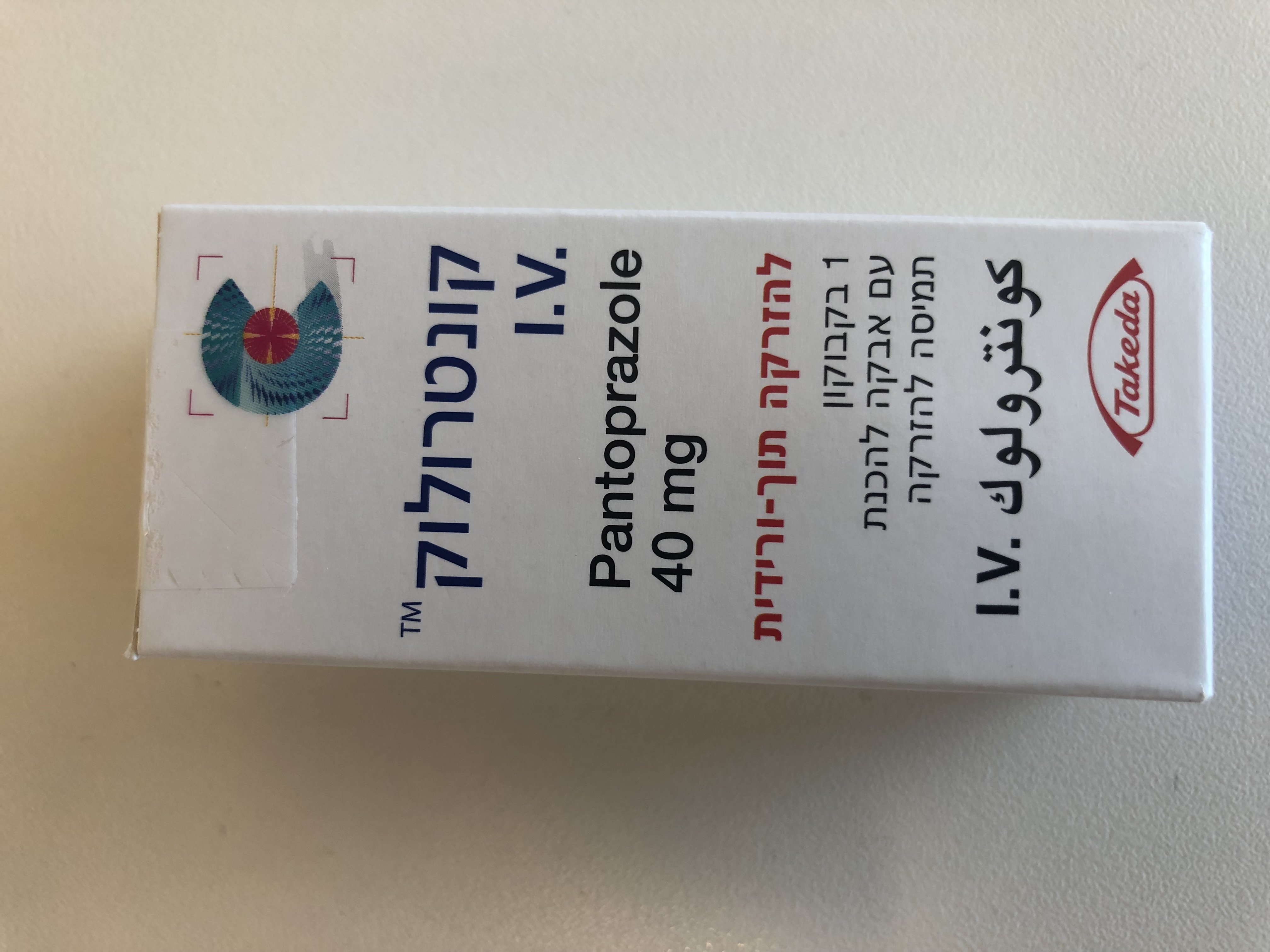Quest for the right Drug

קונטרולוק תוך ורידי CONTROLOC I.V. (PANTOPRAZOLE AS SODIUM)
תרופה במרשם
תרופה בסל
נרקוטיקה
ציטוטוקסיקה
צורת מתן:
תוך-ורידי : I.V
צורת מינון:
אבקה להכנת תמיסה לזריקה : POWDER FOR SOLUTION FOR INJECTION
עלון לרופא
מינוניםPosology התוויות
Indications תופעות לוואי
Adverse reactions התוויות נגד
Contraindications אינטראקציות
Interactions מינון יתר
Overdose הריון/הנקה
Pregnancy & Lactation אוכלוסיות מיוחדות
Special populations תכונות פרמקולוגיות
Pharmacological properties מידע רוקחי
Pharmaceutical particulars אזהרת שימוש
Special Warning עלון לרופא
Physicians Leaflet
Pharmacological properties : תכונות פרמקולוגיות
Pharmacodynamic Properties
5.1 Pharmacodynamic properties Pharmacotherapeutic group: Proton pump inhibitors, ATC code: A02BC02 Mechanism of action Pantoprazole is a substituted benzimidazole which inhibits the secretion of hydrochloric acid in the stomach by specific blockade of the proton pumps of the parietal cells. Pantoprazole is converted to its active form in the acidic environment in the parietal cells where it + + inhibits the H / K -ATPase enzyme, i.e. the final stage in the production of hydrochloric acid in the stomach. The inhibition is dose-dependent and affects both basal and stimulated acid secretion. In most patients, freedom from symptoms is achieved within 2 weeks. As with other proton pump inhibitors and H2 receptor inhibitors, treatment with pantoprazole reduces acidity in the stomach and thereby increases gastrin in proportion to the reduction in acidity. The increase in gastrin is reversible. Since pantoprazole binds to the enzyme distal to the cell receptor level, it can inhibit hydrochloric acid secretion independently of stimulation by other substances (acetylcholine, histamine, gastrin). The effect is the same whether the product is given orally or intravenously. Pharmacodynamic effects The fasting gastrin values increase under pantoprazole. On short-term use, in most cases they do not exceed the upper limit of normal. During long-term treatment, gastrin levels double in most cases. An excessive increase, however, occurs only in isolated cases. As a result, a mild to moderate increase in the number of specific endocrine (ECL) cells in the stomach is observed in a minority of cases during long-term treatment (simple to adenomatoid hyperplasia). However, according to the studies conducted so far, the formation of carcinoid precursors (atypical hyperplasia) or gastric carcinoids as were found in animal experiments (see section 5.3) have not been observed in humans. An influence of a long term treatment with pantoprazole exceeding one year cannot be completely ruled out on endocrine parameters of the thyroid according to results in animal studies. During treatment with antisecretory medicinal products, serum gastrin increases in response to the decreased acid secretion. Also CgA increases due to decreased gastric acidity. The increased CgA level may interfere with investigations for neuroendocrine tumours. Available published evidence suggests that proton pump inhibitors should be discontinued between 5 days and 2 weeks prior to CgA measurements. This is to allow CgA levels that might be spuriously elevated following PPI treatment to return to reference range.
Pharmacokinetic Properties
5.2 Pharmacokinetic properties General pharmacokinetics Pharmacokinetics does not vary after single or repeated administration. In the dose range of 10 to 80 mg, the plasma kinetics of pantoprazole are linear after both oral and intravenous administration. Distribution Pantoprazole's serum protein binding is about 98%. Volume of distribution is about 0.15 L/kg. Biotransformation The substance is almost exclusively metabolised in the liver. The main metabolic pathway is demethylation by CYP2C19 with subsequent sulphate conjugation, other metabolic pathway includes oxidation by CYP3A4. Elimination Terminal half-life is about 1 hour and clearance is about 0.1 L/h/kg. There were a few cases of subjects with delayed elimination. Because of the specific binding of pantoprazole to the proton pumps of the parietal cell the elimination half-life does not correlate with the much longer duration of action (inhibition of acid secretion). Renal elimination represents the major route of excretion (about 80%) for the metabolites of pantoprazole; the rest is excreted with the faeces. The main metabolite in both the serum and urine is desmethylpantoprazole which is conjugated with sulphate. The half-life of the main metabolite (about 1.5 hours) is not much longer than that of pantoprazole. Special populations Poor metabolisers Approximately 3% of the European population lack a functional CYP2C19 enzyme and are called poor metabolisers. In these individuals the metabolism of pantoprazole is probably mainly catalysed by CYP3A4. After a single-dose administration of 40 mg pantoprazole, the mean area under the plasma concentration-time curve was approximately 6 times higher in poor metabolisers than in subjects having a functional CYP2C19 enzyme (extensive metabolisers). Mean peak plasma concentrations were increased by about 60 %. These findings have no implications for the posology of pantoprazole. Renal impairment No dose reduction is recommended when pantoprazole is administered to patients with impaired renal function (including dialysis patients). As with healthy subjects, pantoprazole's half-life is short. Only very small amounts of pantoprazole are dialyzed. Although the main metabolite has a moderately delayed half-life (2 – 3 h), excretion is still rapid and thus accumulation does not occur. Hepatic impairment Although for patients with liver cirrhosis (classes A and B according to Child) the half-life values increased to between 7 and 9 h and the AUC values increased by a factor of 5 - 7, the maximum serum concentration only increased slightly by a factor of 1.5 compared with healthy subjects. Elderly A slight increase in AUC and Cmax in elderly volunteers compared with younger counterparts is also not clinically relevant. Paediatric population Following administration of single intravenous doses of 0.8 or 1.6 mg/kg pantoprazole to children aged 2 - 16 years there was no significant association between pantoprazole clearance and age or weight. AUC and volume of distribution were in accordance with data from adults.

שימוש לפי פנקס קופ''ח כללית 1994
לא צוין
תאריך הכללה מקורי בסל
לא צוין
הגבלות
לא צוין
מידע נוסף
